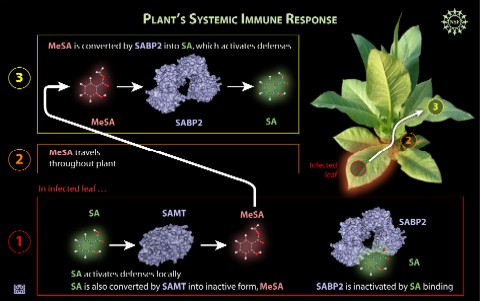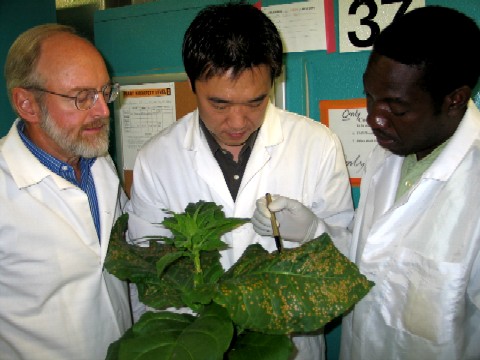Navigation
Asprin-like Hormone Found to Fight Plant Diseases
Scientists have finally identified a key component in the disease-fighting process in plants that activates plant-wide defenses after a pathogen attack.
 |
| The illustration depicts steps involved in the development of a systemic immune response in plants. When a plant is infected by a pathogen, a plant hormone called salicylic acid (SA) activates defenses locally. Some of this SA is converted by an enzyme known as SAMT into an aspirin-like compound called methyl salicylate (MeSA) that travels to uninfected parts of the plant and thereby activates a plant-wide immune response. But some SA at the infection site binds to an enzyme called salicylic acid binding protein 2 (SABP2). This binding prevents the enzyme from converting SA at the infection site into biologically inactive MeSA. Photo: Zina Deretsky, National Science Foundation |
Scientists have finally identified a key component in the disease-fighting process in plants that activates plant-wide defenses after a pathogen attack.
It has long been known that plants often develop a state of heightened resistance, called systemic acquired resistance, following pathogen infection; this phenomenon requires the movement of a signal from the infected leaf to uninfected parts of the plant. Until now, however, no one knew what that signal was.
Researchers at the Boyce Thompson Institute for Plant Research (BTI) have identified methyl salicylate (MeSA), an aspirin-like compound, as a signal that alerts a plant's immune system to shift into high gear. This research, which was funded by the National Science Foundation (NSF), is published in the Oct. 5, 2007, issue of Science.
 |
| Dan Klessig, Sang-Wook Park and Evans Kaimoyo analyze a tobacco plant infected with tobacco mosaic virus. Photo by Dan Klessig, Boyce Thompson Institute for Plant Research |
"Now that we have identified a signal that activates defenses throughout the plant, as well as the enzymes that regulate the level of this signal, we may be able to use genetic engineering to optimize a plant's ability to turn on those defenses," said Daniel F. Klessig of BTI, who heads the research team. "This approach could boost crop production and reduce the use of pesticides, which are potentially harmful to people and/or the environment."
Previous studies conducted by the BTI researchers and others had revealed that after a plant is attacked by a pathogen, it produces a disease-fighting hormone called salicylic acid (SA) at the infection site. Some of this SA activates defenses locally, and some of this SA is converted to MeSA, which is biologically inactive since it cannot induce immune responses.
The BTI researchers' most recent study builds on their previous studies by showing that the MeSA produced at an infection site plays a critical role in the plant's development of systemic acquired resistance. According to this study, MeSA flows from the infection site through the plant's food-conducting tubes (or phloem) to uninfected tissue. Once the MeSA reaches this uninfected tissue, an enzyme known as salicylic acid-binding protein 2 (SABP2) converts the MeSA back into SA. Through this mechanism, "SA is distributed all over the plant, and thereby induces a plant-wide defense response," said Klessig.
The BTI team's conclusions are based on analyses of plants in which SABP2 function was normal, silenced or mutated in different parts/tissues of the plant.
These analyses identified the following steps, which also are shown in the figure, for the development of systemic acquired resistance:
- After a plant is infected with a pathogen, SA is produced at the infection site. Some of this SA is converted into MeSA by an enzyme called SA methyl transferase (SAMT). At the same time, some SA present at the infection site binds with SABP2. Because this binding inactivates SABP2, SABP2 doesn't convert accumulating MeSA back into SA as it does elsewhere in the plant. Therefore, MeSA accumulates at the infection site.
- Accumulated MeSA travels from the infection site to distant, uninfected leaves. Klessig said that it is still unclear why plants send an inactive messenger in the form of MeSA to uninfected tissue where it must be reactivated.
- MeSA arriving at distant, uninfected leaves is converted by the active form of SABP2 into disease-fighting SA, which turns on the plant's defenses.
In addition to improving our understanding of systemic acquired resistance, "this research provides insights into how a hormone like SA can actively regulate its own structure--and thereby determine its own activity--by controlling the responsible enzyme," noted Sang-Wook Park, the study's lead author.
Michael Mishkind, an NSF program director, says that "the discovery that MeSA is a mobile signal for systemic acquired resistance solves a major, long-standing problem, provides novel strategies for crop improvement and raises new fundamental questions likely to generate important insights into the immune system of plants."
Co-Investigators
Daniel Klessig, Boyce Thompson Institute for Plant Research (607) 254-4560 dfk8@cornell.edu
NSF is responsible for the contents of this article. October 7, 2007. http://www.nsf.org/
The National Science Foundation (NSF) is an independent federal agency that supports fundamental research and education across all fields of science and engineering
Search
Latest articles
Agriculture
- World Water Week: Healthy ecosystems essential to human health: from coronavirus to malnutrition Online session Wednesday 24 August 17:00-18:20
- World Water Week: Healthy ecosystems essential to human health: from coronavirus to malnutrition Online session Wednesday 24 August 17:00-18:20
Air Pollution
- "Water and Sanitation-Related Diseases and the Changing Environment: Challenges, Interventions, and Preventive Measures" Volume 2 Is Now Available
- Global Innovation Exchange Co-Created by Horizon International, USAID, Bill and Melinda Gates Foundation and Others
Biodiversity
- It is time for international mobilization against climate change
- World Water Week: Healthy ecosystems essential to human health: from coronavirus to malnutrition Online session Wednesday 24 August 17:00-18:20
Desertification
- World Water Week: Healthy ecosystems essential to human health: from coronavirus to malnutrition Online session Wednesday 24 August 17:00-18:20
- UN Food Systems Summit Receives Over 1,200 Ideas to Help Meet Sustainable Development Goals
Endangered Species
- Mangrove Action Project Collaborates to Restore and Preserve Mangrove Ecosystems
- Coral Research in Palau offers a “Glimmer of Hope”
Energy
- Global Innovation Exchange Co-Created by Horizon International, USAID, Bill and Melinda Gates Foundation and Others
- Wildlife Preservation in Southeast Nova Scotia
Exhibits
- Global Innovation Exchange Co-Created by Horizon International, USAID, Bill and Melinda Gates Foundation and Others
- Coral Reefs
Forests
- NASA Satellites Reveal Major Shifts in Global Freshwater Updated June 2020
- Global Innovation Exchange Co-Created by Horizon International, USAID, Bill and Melinda Gates Foundation and Others
Global Climate Change
- It is time for international mobilization against climate change
- It is time for international mobilization against climate change
Global Health
- World Water Week: Healthy ecosystems essential to human health: from coronavirus to malnutrition Online session Wednesday 24 August 17:00-18:20
- More than 400 schoolgirls, family and teachers rescued from Afghanistan by small coalition
Industry
- "Water and Sanitation-Related Diseases and the Changing Environment: Challenges, Interventions, and Preventive Measures" Volume 2 Is Now Available
- Global Innovation Exchange Co-Created by Horizon International, USAID, Bill and Melinda Gates Foundation and Others
Natural Disaster Relief
- STOP ATTACKS ON HEALTH CARE IN UKRAINE
- Global Innovation Exchange Co-Created by Horizon International, USAID, Bill and Melinda Gates Foundation and Others
News and Special Reports
- World Water Week: Healthy ecosystems essential to human health: from coronavirus to malnutrition Online session Wednesday 24 August 17:00-18:20
- STOP ATTACKS ON HEALTH CARE IN UKRAINE
Oceans, Coral Reefs
- World Water Week: Healthy ecosystems essential to human health: from coronavirus to malnutrition Online session Wednesday 24 August 17:00-18:20
- Mangrove Action Project Collaborates to Restore and Preserve Mangrove Ecosystems
Pollution
- Zakaria Ouedraogo of Burkina Faso Produces Film “Nzoue Fiyen: Water Not Drinkable”
- "Water and Sanitation-Related Diseases and the Changing Environment: Challenges, Interventions, and Preventive Measures" Volume 2 Is Now Available
Population
- "Water and Sanitation-Related Diseases and the Changing Environment: Challenges, Interventions, and Preventive Measures" Volume 2 Is Now Available
- "Water and Sanitation-Related Diseases and the Changing Environment: Challenges, Interventions, and Preventive Measures" Volume 2 Is Now Available
Public Health
- Honouring the visionary behind India’s sanitation revolution
- Honouring the visionary behind India’s sanitation revolution
Rivers
- World Water Week: Healthy ecosystems essential to human health: from coronavirus to malnutrition Online session Wednesday 24 August 17:00-18:20
- Mangrove Action Project Collaborates to Restore and Preserve Mangrove Ecosystems
Sanitation
- Honouring the visionary behind India’s sanitation revolution
- Honouring the visionary behind India’s sanitation revolution
Toxic Chemicals
- "Water and Sanitation-Related Diseases and the Changing Environment: Challenges, Interventions, and Preventive Measures" Volume 2 Is Now Available
- Actions to Prevent Polluted Drinking Water in the United States
Transportation
- "Water and Sanitation-Related Diseases and the Changing Environment: Challenges, Interventions, and Preventive Measures" Volume 2 Is Now Available
- Urbanization Provides Opportunities for Transition to a Green Economy, Says New Report
Waste Management
- Honouring the visionary behind India’s sanitation revolution
- Honouring the visionary behind India’s sanitation revolution
Water
- Honouring the visionary behind India’s sanitation revolution
- Honouring the visionary behind India’s sanitation revolution
Water and Sanitation
- Honouring the visionary behind India’s sanitation revolution
- Honouring the visionary behind India’s sanitation revolution

